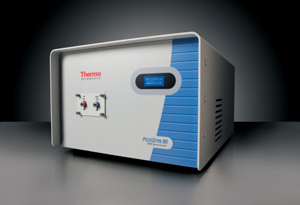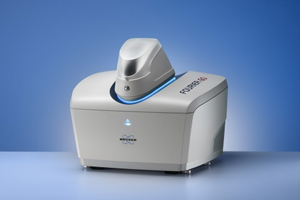
Bruker Corporation, a leading provider of nuclear magnetic resonance (NMR) spectroscopy solutions, announces the introduction of novel high-resolution solid-state NMR scientific capabilities that can enable unprecedented structural biology discoveries in large proteins, membrane proteins and in protein aggregates.
At the 65th ENC (www.enc-conference.org), Bruker introduced a new ultra-fast CP/MAS iProbe as the latest innovation in solid-state NMR technology. Featuring a 160 kHz Magic Angle Spinning (MAS) system, it takes high-resolution MAS and proton detection on solid biological samples to the next level, enabling new scientific discoveries. The dramatically enhanced 1H-NMR resolution and enhanced T2′ times make 160 kHz MAS suitable for the study of large proteins, membrane proteins and protein aggregates. Multiple 160 kHz MAS probes are available for customer demonstrations and collaborations on 700 and 800 MHz NMR spectrometers in Bruker’s applications facility in Germany. In addition, a 160 kHz MAS probe is now installed on the 1.0 GHz NMR at CNRS Lyon, where it expands the scientific capabilities of biological solid-state research.
Professor Guido Pintacuda, CNRS researcher at the Institute of Analytical Sciences in Lyon, commented: “With the new 160 kHz MAS probe we witness a leap forward in resolution, now enabling us to reveal the subtlest nuances of molecular structures and interactions. This is a bold step into the atomic-level description of biomolecules and will contribute to lift the role of NMR in disease research to the next level.”
Bruker also introduces novel technology for standard-bore (SB) DNP Probes for 600 and 800 MHz, and eventually for GHz SB magnets to allow scientists to study small molecules, proteins or materials with ultrahigh DNP-NMR sensitivity. The new SB-DNP probe technology broadens the accessibility of solid-state DNP-NMR research. Previously, wide-bore (WB) NMR magnets were required for DNP, and now the same DNP-NMR sensitivity enhancements of 50x to 200x can be achieved with more economical and widely adopted SB NMR magnets.
The new HCN SB DNP probes are available for LT-MAS below 100 Kelvin, with 1.3 mm or 0.7 mm MAS rotor diameters for high-resolution MAS even at low temperatures. Bruker is in the process of developing high-field gyrotrons for microwave frequencies of 658 GHz to 790 GHz for solid-state DNP-NMR at 1.0 and 1.2 GHz.
About Bruker Corporation – Leader of the Post-Genomic Era (Nasdaq: BRKR)
Bruker is enabling scientists and engineers to make breakthrough post-genomic discoveries and develop new applications that improve the quality of human life. Bruker’s high performance scientific instruments and high value analytical and diagnostic solutions enable scientists to explore life and materials at molecular, cellular, and microscopic levels. In close cooperation with our customers, Bruker is enabling innovation, improved productivity, and customer success in post-genomic life science molecular and cell biology research, in applied and biopharma applications, in microscopy and nanoanalysis, as well as in industrial and cleantech research, and next-gen semiconductor metrology in support of AI. Bruker offers differentiated, high-value life science and diagnostics systems and solutions in preclinical imaging, clinical phenomics research, proteomics and multiomics, spatial and single-cell biology, functional structural and condensate biology, as well as in clinical microbiology and molecular diagnostics.
For more information, please visit www.bruker.com.



